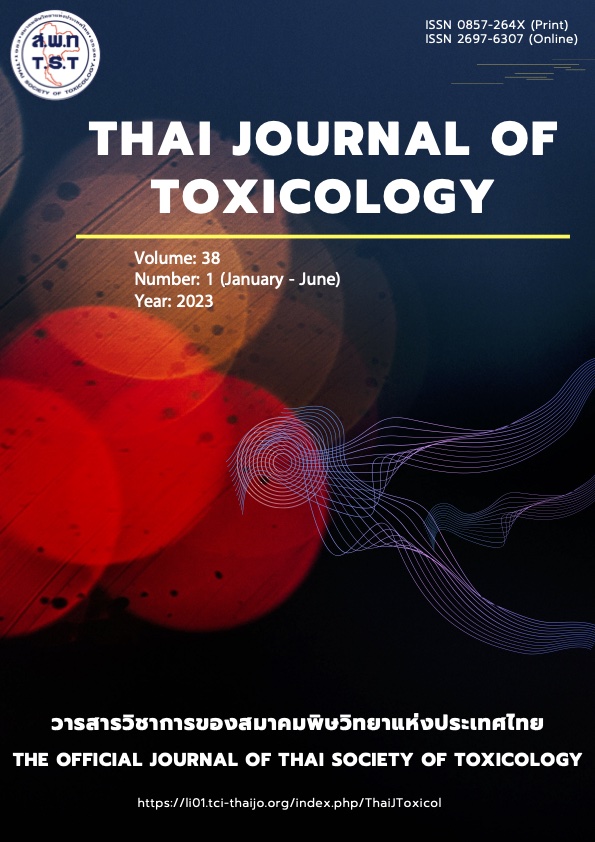Use of Nuclear ITS Region as DNA Barcode Marker for the Species Identification of Mushroom in the Genus Macrocybe Causing Foodborne Illness
Main Article Content
Abstract
Macrocybe is a macrofungal genus that contains eight reported species worldwide. In Thailand, there are two species including M. crassa (Hed Taen Rad, edible) and M. gigantea (without edibility information). Both species have similar morphology. According to the Toxicology Center database, cases of Macrocybe poisoning have been reported frequently and specimens closely resembled edible M. crassa. Hence, this study aimed to identify species of Macrocybe from seven poisoning cases during 2012 to 2022 based on the nuclear internal transcribed spacer (ITS) sequence data. Nucleotide similarity was identified using BLASTN and BOLD (Barcode of Life Database System). Phylogenetic characterization was analyzed using maximum likelihood (ML) method. Results based on BLASTN and BOLD databases revealed high nucleotide similarities of clinical mushroom specimens to M. gigantea. Phylogenetic tree obtained from ML analysis confirmed that the Macrocybe mushrooms ingested by the patients was M. gigantea. Although this species was deemed as an edible mushroom in India. However, there were reports of food poisoning caused by M. gigantea in China. In Thailand, there were cases where patients exhibited gastrointestinal symptoms between 2 to 3.30 hours after ingestion. This indicated that some edible mushrooms can be toxic to humans.
Article Details
References
Chandrasrikul A, Suwanarit P, Sangwanit U, et al. Checklist of Mushrooms (Basidio-mycetes) in Thailand. Bangkok, Thailand: Office of Natural Resources and Environmental Policy and Planning; 2011. 448 p.
อุทัยวรรณ แสงวณิช, พูนพิไล สุวรรณฤทธิ์, อัจฉรา พยัพพานนท์, และคณะ. บัญชีรายการทรัพย์สินชีวภาพ เห็ด. สำนักงานพัฒนาเศรษฐกิจจากฐานชีวภาพ (องค์กรมหาชน); 2556. 374 หน้า.
Naksuwankul K, Thongbor A, Chantharasena C, et al. Identification by Morphological and Local Wisdom and Distribution of Poisonous and Edible Mushroom in Thailand. BUSCIJ 2022; 27(1): 66-84.
Nooron N, Parnmen S, Sikaphana S, et al. The situation of mushrooms food poisoning in Thailand: Symptoms and common species list. Thai J Toxicol 2020; 35: 58-69.
White J, Weinstein SA, De Haro L, et al. Mushroom poisoning: A proposed new clinical classification. Toxicon 2019; 157: 53-65.
Bresinsky A, Besl H. A colour atlas of poisonous fungi: A handbook for pharmacists, doctors, and biologists. London: Wolfe Publishing Ltd, 1990. 295 p.
Assisi F. Wild mushrooms: food poisoning prevention guide. Milan: Poison Control Centre of Milan, 2015. 26 p.
Parnmen S, Sikaphan S, Leudang S, et al. Molecular identification of poisonous mushrooms using nuclear ITS region and peptide toxins: a retrospective study on fatal cases in Thailand. J Toxicol Sci 2016; 41(1): 65-76.
Ratnasingham S, Hebert PD. BOLD: The Barcode of Life Data System. Molecular ecology notes 2007; 7(3): 355-64. Available at http://www.barcodinglife.org, accessed on April 5 2023.
Pegler D, Lodge D, Nakasone K. The Pantropical Genus Macrocybe Gen. nov. Mycologia 1998; 90: 494.
Morgulis A, Coulouris G, Raytselis Y, et al. Database indexing for production MegaBLAST searches. Bioinformatics 2008; 24(16): 1757-64.
Stamatakis A. RAxML version 8: a tool for phylogenetic analysis and post-analysis of large phylogenies. Bioinformatics 2014; 30(9): 1312-13.
Miller MA, Pfeiffer W, Schwartz T. Creating the CIPRES Science Gateway for Inference of large phylogenetic trees. In: Proceeding of the Gateway Computing Environments Workshop (GCE). New orleans; 2010, 1–8.
Price MN, Dehal PS, Arkin AP. FastTree 2–approximately maximum-likelihood trees for large alignments. PloS one 2010; 5(3): e9490.
Das AK, Nanda PK, Dandapat P, et al. Edible Mushrooms as Functional Ingredients for Development of Healthier and More Sustainable Muscle Foods: A Flexitarian Approach. Molecules 2021; 26(9): 2463.
ขวัญเรือน นาคสุวรรณ์กุล. สารปรับปรุงภูมิคุ้มกันจากเห็ดที่มีฤทธิ์ทางยา. KKU Sci J 2018; 46(3) : 395-407.
Duffy TJ. Toxic fungi of western North America. Group. MykoWeb, 2008. 166 p.
Boonpratuang T, Choeyklin R, Promkium-on P, et al. The identification of poisonous mushrooms in Thailand during 2008-2012. Thai Mushroom 2012; 6–13.
Naksuwankul K, Thongbor A, Chantharasena C, et al. Classification of poisonous mushroom base on morphological charac-teristics and indigenous knowledge at Ubon Ratchathani province. KKU Sci J 2021; 49(1): 40–57.
Leudang S, Sikaphan S, Parnmen S, et al. DNA-based identification of gastrointestinal irritant mushrooms in the genus Chlorophyllum: A food poisoning case in Thailand. J Health Res 2017; 31(1): 41-9.
Parnmen S, Nooron N, Leudang S, et al. Phylogenetic evidence revealed Cantharocybe virosa (Agaricales, Hygrophoraceae) as a new clinical record for gastrointestinal mushroom poisoning in Thailand. Toxicol Res 2020; 36: 239-48.
Razaq A, Nawaz R, Khalid AN. An Asian edible mushroom, Macrocybe gigantea: its distribution and ITS-rDNA based phylogeny. Mycosphere 2016; 7(4): 525–30.
Inyod T, Sassanarakit S, Payapanon A, Keawsompong S. Selection of Macrocybe crassa mushroom for commercial production. Agric Nat Resour 2016; 50(3): 186–191.
Li H, Zhang H, Zhang Y, et al. Mushroom Poisoning Outbreaks–China, 2019. China CDC Wkly 2020; 2 (2): 19–24.


